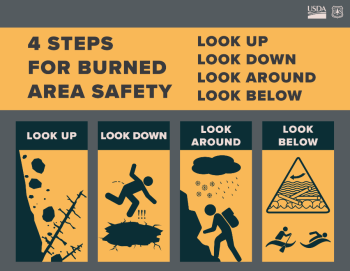Safety in Burned Areas
After a wildfire, visitors should expect a changed experience out on the landscape. This could include hard-to-navigate stands of burned trees, eroded slopes, or missing sections of trail.
Burned areas can also have an increased likelihood of landslides, mudslides, flash floods, and debris flows. Hikers always assume risks when entering trails in natural areas, but in burned areas those risks are greater. Your safety is in your hands!
Play it safe by choosing activities that are within your comfort zone. As fire-damaged areas reopen, they may have unmarked hazards and may be more challenging in rescue situations.
Learn the Risks
Risks in burned areas include falling trees and limbs, uneven/unstable ground full of holes from burned root systems, falling rocks, difficulty navigating through sections of trail, and possible landslides, debris flows, and flash floods. These are elevated during high winds, and during and after heavy rains and winter storms.
Know Your Route
Plan your hike and hike your plan!
Bring a quality map showing topography and natural features and a compass and/or a proper GPS unit that you know how to use. Cross-check your route against maps of the burned area so you know more about what to expect.
Check the Weather Before Heading Out
Weather is a major trigger for hazards. Check the 48-hour weather outlook before heading out. Here's what to watch for:
- High winds knock down standing dead trees and branches, creating serious risks for those on hiking trails. If high or gusty winds are forecasted, do not go into a burned area. If wind picks up while in an area, leave immediately.
- Major storms including rain or snow can trigger flash floods, landslides, and debris flows.
Stay on Established Trails
If trail signs are missing or downed trees and landslides make it hard to follow the trail, stick within your comfort level with navigating through natural areas. Turn back if necessary.
Look and Listen for Hazards
While in a burned area, SCAN for overhead hazards, such as rock or tree fall hazards. LISTEN for high winds and falling trees, limbs, and rocks. WATCH OUT for stump holes, unstable ground, and increased stream flows.
Know When to Turn Around
The trails and areas that remain closed are among the worst hit by the fire and include extreme post-fire hazards. Respect signs, barriers, and fences and turn around when you encounter closed areas. Please remember that entering closed areas creates risks for others, such as first responders. If wind picks up while in an area, leave immediately.




